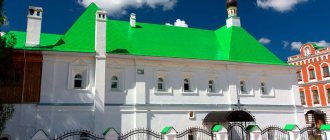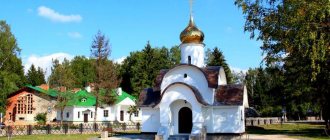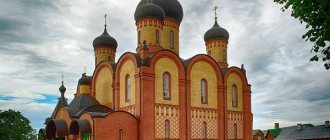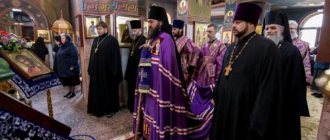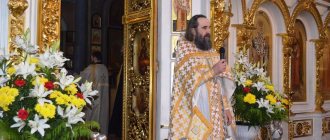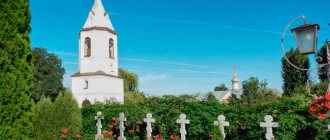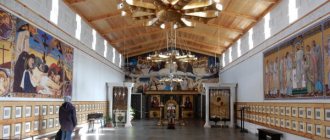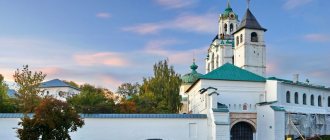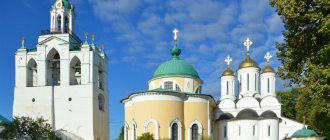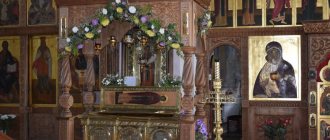Mir
Russia Novgorod region village of Khutyn Varlaamo-Khutyn Spaso-Preobrazhensky Convent Map is loading…
{"format":"leaflet","minzoom":false,"maxzoom":false,"limit":50,"offset":0,"link":"all","sort":[""], "order":[],"headers":"show","mainlabel":"","intro":"","outro":"","searchlabel":"\u2026 \u0441\u043b\u0435\ u0434\u0443\u044e\u0449\u0438\u0435 \u0440\u0435\u0437\u0443\u043b\u044c\u0442\u0430\u0442\u044b","default":"","import-annotation":false,"width ":"auto","height":"350px","centre":{"text":"","title":"""link":"","lat":58.58749999999999857891452847979962825775146484375,"lon": 31.395832999999999657347871107049286365509033203125,"icon":""},"title":"","label":"","icon":"","lines":[],"polygons":[],"circles":[ ],"rectangles":[],"copycoords":false,"static":false,"zoom":8,"defzoom":14,"layers":["OpenStreetMap"],"image layers":[] ,"overlays":[],"resizable":false,"fullscreen":true,"scrollwheelzoom":true,"cluster":false,"clustermaxzoom":9,"clusterzoomonclick":true,"clustermaxradius":80, "clusterspiderfy":true,"geojson":"","clicktarget":"","showtitle":true,"hidenamespace":false,"template":"","userparam":"","activeicon": "","pagelabel":false,"ajaxcoordproperty":"","ajaxquery":"","locations":[{"text":"\u003Cb\u003E\u003Ca href=\"/palomnik/%D0% 92%D0%B0%D1%80%D0%BB%D0%B0%D0%B0%D0%BC%D0%BE-%D0%A5%D1%83%D1%82%D1%8B%D0%BD %D1%81%D0%BA%D0%B8%D0%B9_%D0%A1%D0%BF%D0%B0%D1%81%D0%BE-%D0%9F%D1%80%D0%B5% D0%BE%D0%B1%D1%80%D0%B0%D0%B6%D0%B5%D0%BD%D1%81%D0%BA%D0%B8%D0%B9_%D0%B6%D0% B5%D0%BD%D1%81%D0%BA%D0%B8%D0%B9_%D0%BC%D0%BE%D0%BD%D0%B0%D1%81%D1%82%D1%8B% D1%. 421 \u043f\u0430\u0441\u043e-\u041f\u0440\u0435\u043e\u0431\u0440\u0430\u0436\u0435\u043d\u0441\u043a\u0438\u0439 \u0436\u0435\ u043d\u0441\u043a\u0438\ u0439\u043c\u043e\u043d\u0430\u0441\u0442\u044b\u0440\u044c\»\u003E\u0412\u0430\u0440\u043b\u0430\u0430\u043c\u043e-\u0425\ u0443\u0442\u044b\u043d \u0441\u043a\u0438\u0439 \u0421\u043f\u0430\u0441\u043e-\u041f\u0440\u0435\u043e\u0431\u0440\u0430\u0436\u0435\u043d\u0441\ u043a\u0438\u0439\u0436\ u0435\u043d\u0441\u043a\u0438\u0439 \u043c\u043e\u043d\u0430\u0441\u0442\u044b\u0440\u044c\u003C/a\u003E\u003C/b\u003E\u003Ch r /\u003E\u003Ca href= \"/palomnik/%D0%A1%D0%B2%D0%BE%D0%B9%D1%81%D1%82%D0%B2%D0%BE:%D0%90%D0%BD%D0%BD %D0%BE%D1%82%D0%B0%D1%86%D0%B8%D1%8F\" title=\"\u0421\u0432\u043e\u0439\u0441\u0442\u0432\u043e:\u0410\ u043d\u043d\u043e\u0442\u0430\u0446\u0438\u044f\»\u003E\u0410\u043d\u043d\u043e\u0442\u0430\u0446\u0438\u044f\u003C/a\u003E: »'\u0412\u0430 \u0440\u043b\u0430\u0430\u0301\u043c\u043e-\u0425\u0443\u0301\u0442\u044b\u043d\u0441\u043a\u0438\u0439 \u0421\u043f\u0430\ u0441\u043e-\u041f\u0440 \u0435\u043e\u0431\u0440\u0430\u0436\u0435\u043d\u0441\u043a\u0438\u0439 \u043c\u043e\u043d\u0430\u0441\u0442\u044b\u0440\u 044c"' \u2014 \u0436\u0435 \u043d\u0441\u043a\u0438\u0439 (\u0440\u0430\u043d\u0435\u0435 \u2014 \u043c\u0443\u0436\u0441\u043a\u043e\u0439) \u043c\u04 3e\u043d\u0430\u0441\u0442 \u044b\u0440\u044c \u041d\u043e\u0432\u0433\u043e\u0440\u043e\u0434\u0441\u043a\u043e\u0439 \u0435\u043f\u0430\u0440\u0445\ u0438\u0438\u0420\u0443\u0441 \u0441\u043a\u043e\u0439 \u041f\u0440\u0430\u0432\u043e\u0441\u043b\u0430\u0432\u043d\u043e\u0439 \u0426\u0435\u0440\u043a\ u0432\u0438","title": "" \u0441\u043e-\u041f\ u0440\u0435\u043e\u0431\u0440\u0430\u0436\u0435\u043d\u0441\u043a\u0438\u0439 \u0436\u0435\u043d\u0441\u043a\u0438\u0439 \u0 43c\u043e\u043d\u0430\u0441\ u0442\u044b\u0440\u044c","link":"","lat":58.58749999999999857891452847979962825775146484375,"lon":31.39583299999999965734787110704928 6365509033203125,"icon":""}],,"imageLayers":[]}
58.587628; 31.395499
Russia, Novgorod district, Savinskoye rural settlement, Khutyn village, Monastyrskaya street, 59
Khutyn village, Novgorod region 173011
Russia
Telephone.:
8 (8162) 74-96-02 (pilgrimage center), 8 (921) 201-56-41 (hotel on the territory of the monastery)
Varlaamo-Khutyn Spaso-Preobrazhensky Monastery
- a female (formerly male) monastery of the Novgorod diocese of the Russian Orthodox Church, located on the right bank of the Volkhov River in the Novgorod district of the Novgorod region, on the northern outskirts of the village of Khutyn, 7 km from Veliky Novgorod and 3 km (in a straight line) from Krechevitsy.
History[[edit]h2>
According to folk legend, this place was under the power of evil spirits and was called “Khutyn”, that is, a bad place. Here the monk Varlaam (in the world Alexa Mikhalevich) retired to prayer. One day Prince Yaroslav came to him. Saint Varlaam, blessing him, said, “Be healthy, prince, and with your noble son.” This greeting amazed the prince, who did not yet know about the birth of the baby (this was in 1190). Having cut down the cell and having won victory over evil spirits, he erected first a wooden and then a stone temple in the name of the Transfiguration of the Lord (Church of the Savior in Khutyn). The church was consecrated on August 6, 1192 by Archbishop Gregory. The temple has not survived. In 1515, the Transfiguration Cathedral was built. The most famous building of the monastery is the Church of Gregory of Armenia.
In 1471, John Vasilyevich the Third came to the Khutyn Monastery to venerate the holy relics, and, according to legend, he began to ask the abbot why the crayfish were not opened so that everyone could venerate the holy relics. When, at his command, they began to dig up the grave of the Monk Varlaam, a pillar of fire burst out of the ground, scorching the wall and the southern door of the iconostasis. The Grand Duke ran out of the church in horror, striking the ground with his staff, and fire came out of the ground not only in the church, but also in the monastery. Throwing away his staff, the Grand Duke left the monastery in great fear. This staff and the scorched altar door were kept in the monastery sacristy.
In 1553-1557, the abbot of the monastery was a major hagiographer and the most prominent singer of the Novgorod school of the 16th century, Markell Bezborody.
In 1611, the monastery became the residence of the command of the Swedes who attacked Veliky Novgorod.
Since the mid-18th century, the abbots of the Khutyn Monastery were vicars of the Novgorod diocese, who bore the title of Kexholm and Ladoga (1759-1763), Starorussky (1787-1892), Kirillovsky (1892-1907), Tikhvinsky (1907-1921).
The ashes of the great Russian poet Gabriel Romanovich Derzhavin and his wife Daria Alekseevna are buried in the Spaso-Preobrazhensky Cathedral of the Khutyn Monastery. Derzhavin died in 1816 in his house on the Zvanka estate. The coffin with the body of the deceased on a barge along the Volkhov went to its final resting place. Archbishop Anthony (Znamensky), Bishop of Starorussky Sylvester (Tsvetkov) and Bishop of Kirillov Arseny (Ivashchenko) were also buried in the monastery cathedral.
The monastery was closed in 1925, but until 1932 services were still held in the monastery cathedral. The title of Archbishop of Khutyn was held by Alexy (Simansky); in the cathedral in 1930-1932, the future Archimandrite Pavel (Gruzdev) sang and read in the choir.
During the Great Patriotic War, the monastery was destroyed and remained in ruins for more than 40 years. Derzhavin’s grave was also damaged. In 1959, the remains of the poet and his wife were reburied in Novgorod Detinets. In 1993, in connection with the 250th anniversary of the poet, his remains were returned to the monastery.
Shrines and patronal feasts
The main shrine of the monastery is the relics of St. Varlaam; pilgrims from all over the world come to them.
Patronal holidays are considered:
- On August 19, on the day of the Transfiguration of the Lord, thousands of pilgrims come to the Khutyn women's monastery to share the patronal holiday.
- November 19 is the day of remembrance of Saint Varlaam of Khutyn, who rested on this day many centuries ago.
Divine service at the Varlaamo-Khutyn Monastery
Current state[[edit]h2>
Since April 20, 1994, it has been an active convent. Abbess: Abbess Alexia (Simdyankina). About 100 sisters live in the monastery, and there is a courtyard in the village of Bykovo, Valdai region.
The confessor of the monastery is Abbot Macarius (Shamsutdinov). According to one of the pilgrims: “The most indelible impression on me was made by Father Abbot Macarius. In the busy world in which we live, I am amazed every time I meet such amazing people. I would compare Father Macarius’s attitude towards other people with the kindness and love of Christ. Next to such a person, you begin to feel light within yourself. As a child, you learn to love people in a new way, and for that I am grateful. I will carry the image of his glowing smile with me throughout my life.” In the words of another pilgrim: “He has from the Lord the gift of love and consolation. No matter how many pilgrims come, he has a smile and a kind word for everyone, he anoints everyone with oil on the hill after the prayer service, everyone is prepared with a bucket of water from the well, regardless of the weather and time of year. Pilgrims jokingly call Fr. Macarius as a hydromonk." K o. People from many cities in Russia come to Macarius for spiritual advice and help; he receives confession before the start of the Liturgy.
Interior decoration
The interior decoration of the Church of the Transfiguration was restored in the traditions of the 16th century, with an open arch of the altar opening and a chapel iconostasis. The walls of the temple are decorated with flat pilasters, which serve as visual support for the arches of the chapel. The corner pillars have a double shape, which creates a clear rhythm and integrity of the interior. The walls are divided in height by a cornice under the windows.
The dome is light, with narrow, raised arches creating a feeling of lightness and spaciousness. The entire interior is very bright and spacious. An interesting feature is the stone staircase leading from the opening in the chancel to the dome, the purpose of which is not precisely established.
How to get there[[edit]h2>
Directions:
The Khutyn monastery is quite accessible from the point of view of public transport. Getting to Novgorod should not be difficult. Bus No. 121 runs quite regularly from the Novgorod bus station (Oktyabrskaya str., 1, next to the railway station) to Khutyn. Schedule here. By car from the center of Novgorod you need to go along Bolshaya Moskovskaya Street to the intersection with Derzhavin Street. Here turn right and follow the sign for Khutyn (turn left). After a while there will be a fork. You need to turn left, onto Monastyrskaya Street. She will lead you to the monastery.
Address:
Novgorod region, Novgorod district, Khutyn village.
Tel.:
8 (8162) 74-96-02 (pilgrimage center), 8 (921) 201-56-41 (hotel on the territory of the monastery)
Architectural ensemble of the monastery
To the north-west of the main temple of the monastery there is a domed columnless church of Varlaam Khutynsky with a rich refectory, built in the mid-16th century. The structure has a square plan, extending outwards towards the top, with 3 apses. Inside the building is divided into 2 floors. There was a kitchen in the basement.
The refectory in the western part is a large and bright hall with two octagonal columns and starry vaults. In front of the entrance to the Transfiguration Church, above the southern entrance to the monastery, there is a church with a bell tower, built in the Baroque style in the shape of a triumphal arch. The lower floors of the bell tower are massive, of the same size, and decorated with columns.
Against the background of such a base, the completeness of the bell level looks rather poor. The architect of the building was D.V. Ukhtomsky. On the 2nd floor today there is a temple of the new martyrs and confessors of Russia. The sister building is a two-story building with a house church, consecrated in honor of the Roman saint Pope Leo.
On the territory of the monastery there is a hill, which was built by the monk himself, building a cave cell. Today a wooden chapel stands above it. A canopy dug by Varlaam himself was installed over the well. All monastery buildings with an orchard are surrounded by a white stone fence.
Service schedule, operating hours
The monastery is open to pilgrims and parishioners daily from 6.00 to 21.30. Everyone can take part in the daily services, which begin at the Varlaam-Khutyn Church according to the following schedule.
Program:
- The Divine Liturgy on weekdays is celebrated from 7 am.
- Evening worship begins on weekdays at 18:00.
- Night vigils are held on the eve of public holidays and on Sundays from 5 p.m.
- Sunday liturgy begins at 10 o'clock
- Confession is made before the start of morning services at 6:30 and 8:30.
After Mass at 12 noon, weekly prayer is held at St. Barlaam. On Saturday after the morning service, by prior arrangement, the sacrament of baptism is performed.
Mentors
Over its long history, the monastery has changed a huge number of mentors, many of whom were glorified as saints.
The Orthodox Church especially noted:
- Monk abbot Anthony of Dymsky, appointed by the Monk Varlaam as head of the monastery.
- Saint Anthony of Pskov and Novgorod.
Today the abbess of the monastery is nun Alexia Simdyankina.
Donation
Recommended donation for 1 name:
- Prayer service, memorial service, proskomedia (1 day) - 5 rubles
- Proskomedia, Sorokoust (40 days) - 300 rubles
- Proskomedia (1 year) - 1000 rubles
- Indestructible Psalter (1 year) - 1000 rubles.
For the existence of the monastery and its inhabitants, material resources are necessary. Therefore, we ask you for a voluntary donation for the needs of the monastery. The form automatically calculates the recommended donation. You can change its size at your discretion.
If you are in a difficult financial situation that does not allow you to donate to the monastery, write us a letter to
and explain the situation. The decision will be made individually.
Sorokoust
Special mention should be made of Sorokoust for his health and peace. In the prayer practice of the Orthodox Church, there is a widespread custom of praying in church for a certain amount of time for the sick, sick, or already deceased children of the Church.
Why the number forty? Because it is significant and occurs frequently in Holy Scripture. The Jewish people wandered in the desert for 40 years. The prophet Moses fasted for 40 days. Jesus Christ spent 40 days after His Baptism in the desert. For 40 days after His Resurrection, the Savior taught the Apostles the secrets of the Kingdom of God. As Saint Simeon of Thessalonica wrote, the forty-mouth is also performed in remembrance of the event of the Ascension of the Lord, which occurred on the fortieth day after His Resurrection, so that the deceased, “rising from the grave, ascended to the meeting, that is, to meet.” The custom of praying for the dead for 40 days was legitimized in the Church by the first Apostles. Since then, the Church, following tradition, offers its prayers to God for 40 days both for the living and for the dead. This is how it turns out that when ordering a magpie for daily church prayer, we need to remember that all the people commemorated in it, including the deceased, also participate in the Liturgy.
Sorokoust “On Health”
they order not only for the health of loved ones and the sick, but also for their success, material well-being, peace of mind, and solutions to important everyday and spiritual issues. After all, the concept of “health” is very broad and includes not only the physical, but also the spiritual state of a person.
Rules for visiting the monastery
When visiting the monastery, you should observe the following generally accepted rules for Orthodox Christians:
- The pilgrim must wear a pectoral cross.
- Before entering the monastery, a woman must cover it with a scarf, and a man must uncover his head, sign with the triple sign of the cross and bow.
- It is recommended to turn off or mute your mobile phone.
- It is not customary to speak loudly, laugh, run or make noise on the territory of the monastery.
- you have to match the situation. You cannot enter the monastery in shorts, T-shirts, or tracksuits.
- Believers cannot be prevented from praying, pressed, or distracted by questions during the service.
- It is customary to buy and light candles from the Saints before or after the service.
- During worship, it is not advisable to walk around the church and kiss icons.
- Pilgrims living in the monastery must respect the structure and routine of the monastery.
A note by mail or electronically?
Please note that it is still possible to order services by postal order to the address: 186756, Republic of Karelia, Sortavala district, Valaam island, Spaso-Preobrazhensky Monastery, Zherdev Vladislav Petrovich. When sending a note by mail, you must keep in mind that Valaam is an island, and postal receipts arrive no earlier than a week later, and during periods of bad weather - with an even greater delay.
If previously you had to travel quite a long way to get to the monastery yourself, or find a person going on a pilgrimage, and all this took more than one day, now the process of submitting a note takes a matter of minutes.
Now, thanks to the fact that the monastery has developed a special module for accepting donations, the requirements can be fulfilled much earlier. Each name is carefully entered into a special list. This is a special obedience in the monastery, the observance of which is very strict and strictly monitored to ensure that the names are read at the appropriate time. More details
Mid-price hotels
Hotel "Volkhov" is located in the very center of the city, providing guests with comfortable rooms with all amenities. The price includes a buffet breakfast.
- Address: st. Predtechenskaya, 24.
- Phone (reservation), (administrator).
- Cost of living: single room: 2150 rubles, double room: 2900–3100 rubles.
Hotel "Novgorodskaya" is located on a quiet street in the very center of the city. Guests are offered rooms with all amenities, breakfast, and free Wi-Fi.
- Address: st. Desyatinnaya, 6A.
- Telephone.
- Cost of living: from 2000 rub.
The Yuryevskoe Podvorye complex is a spacious countryside tourist complex designed to accommodate organized groups. Stylized numbers.
- Website: www.tk-podvorie.ru
- Address: Yuryevskoe highway, 6A
- Phone, fax, 94-60-63.
- Cost of living: from 2800 rub.
A special rite is the reading of the Indestructible Psalter
During the continuous reading of the Psalter, lists of names are remembered in order at each kathisma. Separate commemorations (synodics) are held for prayer for the health and salvation of the living, and others for the repose of the souls of departed Orthodox Christians. Health and funeral synodics are read alternately.
In the monastery they pray for the health of the clergy, for the inhabitants and workers of the monastery, for benefactors and their relatives, donors and for all those who work in the monastery.
According to the existing charter of the Valaam Monastery, the book of Psalms itself is never closed. In the afternoon, reading the Psalter in the Church of the Valaam Icon of the Mother of God. The gatekeepers at the Holy Gates of the monastery strictly ensure that the readers, taking turns, start reading the Indestructible Psalter on time, carefully replacing each other. At night, the reading of the Psalter is transferred to the St. Nicholas Skete, where the monks who live in the monastery most of all continue to read in the house church, which is closed to pilgrims. A schedule is drawn up for every day and every night, each shift lasts one to two hours.
Reading the Incessant Psalter is loved among the inhabitants of the Valaam monastery. It flows in silence, reverent mood and pacifies the soul. The Psalter is perceived as an integral part of monastic prayer life. Reading the Psalter means showing love for your neighbors - both relatives and complete strangers. It is especially touching when the “seriously ill”, “suffering”, “lost”, “missing” are mentioned.
